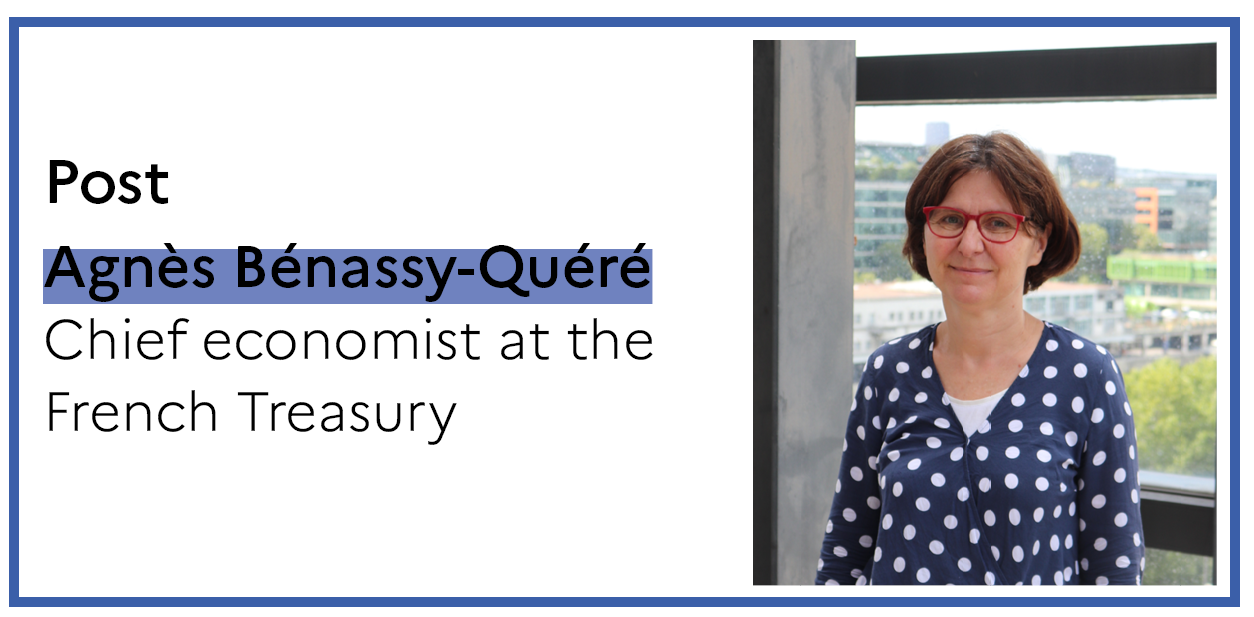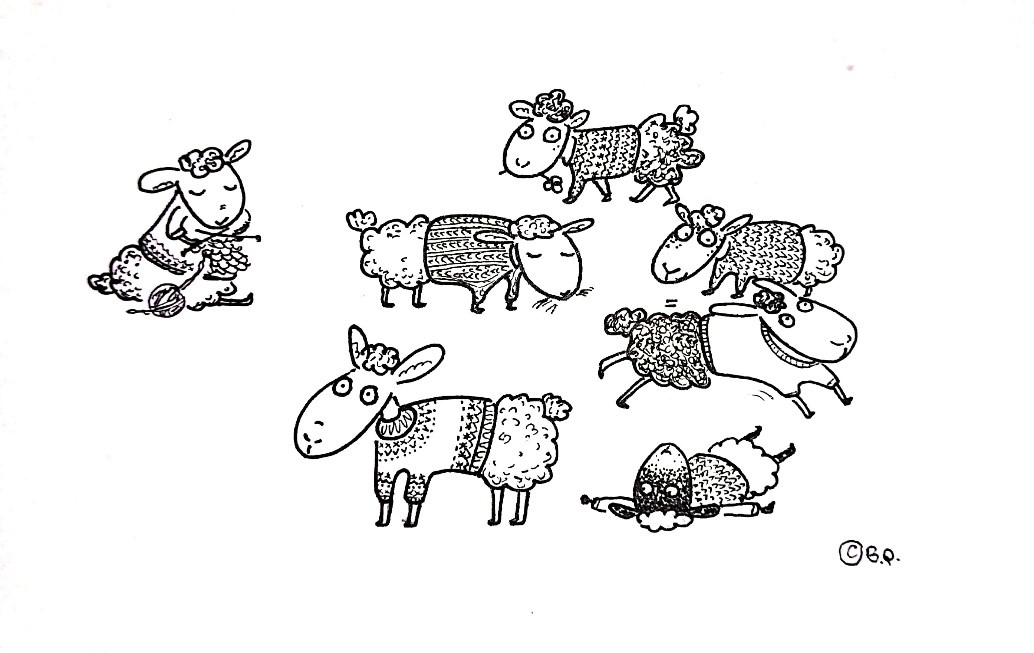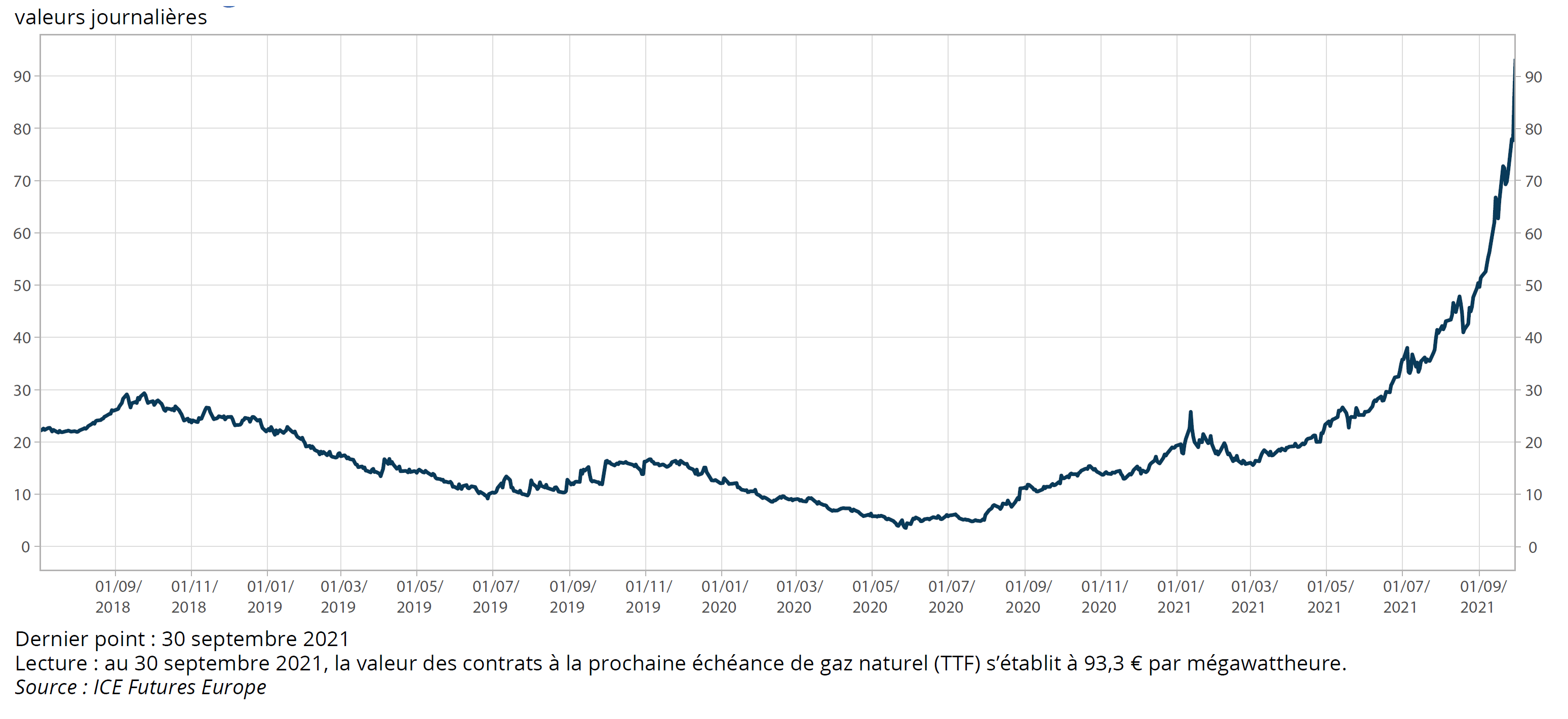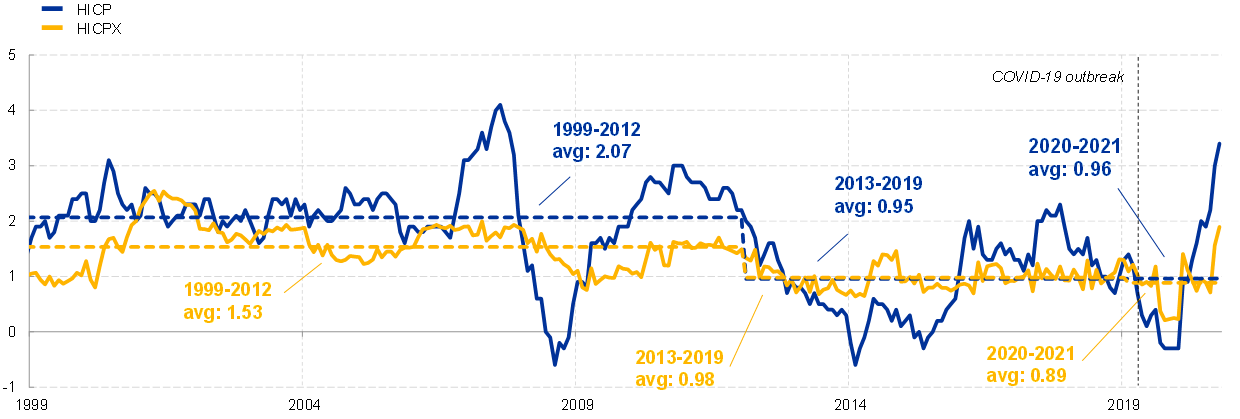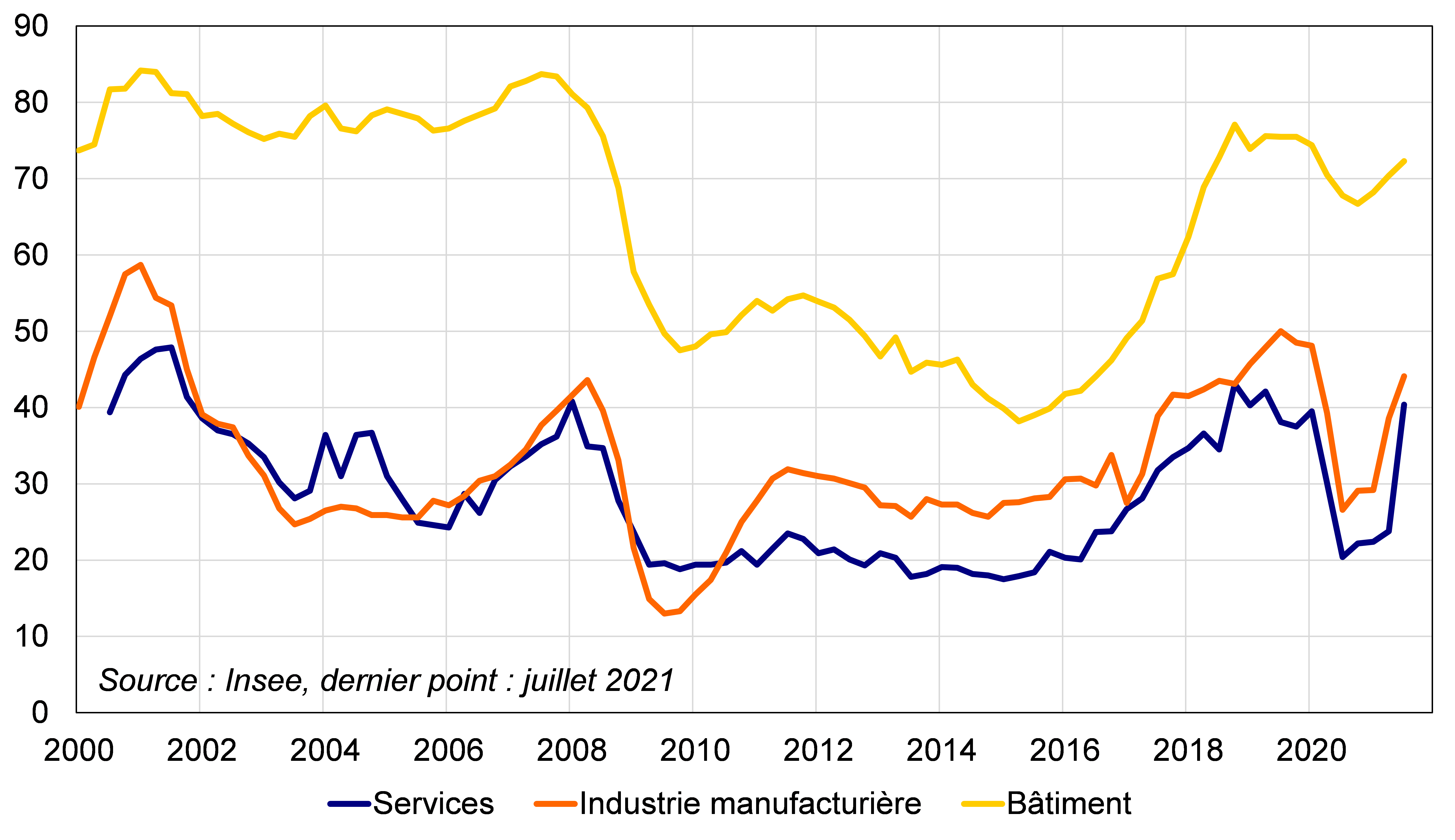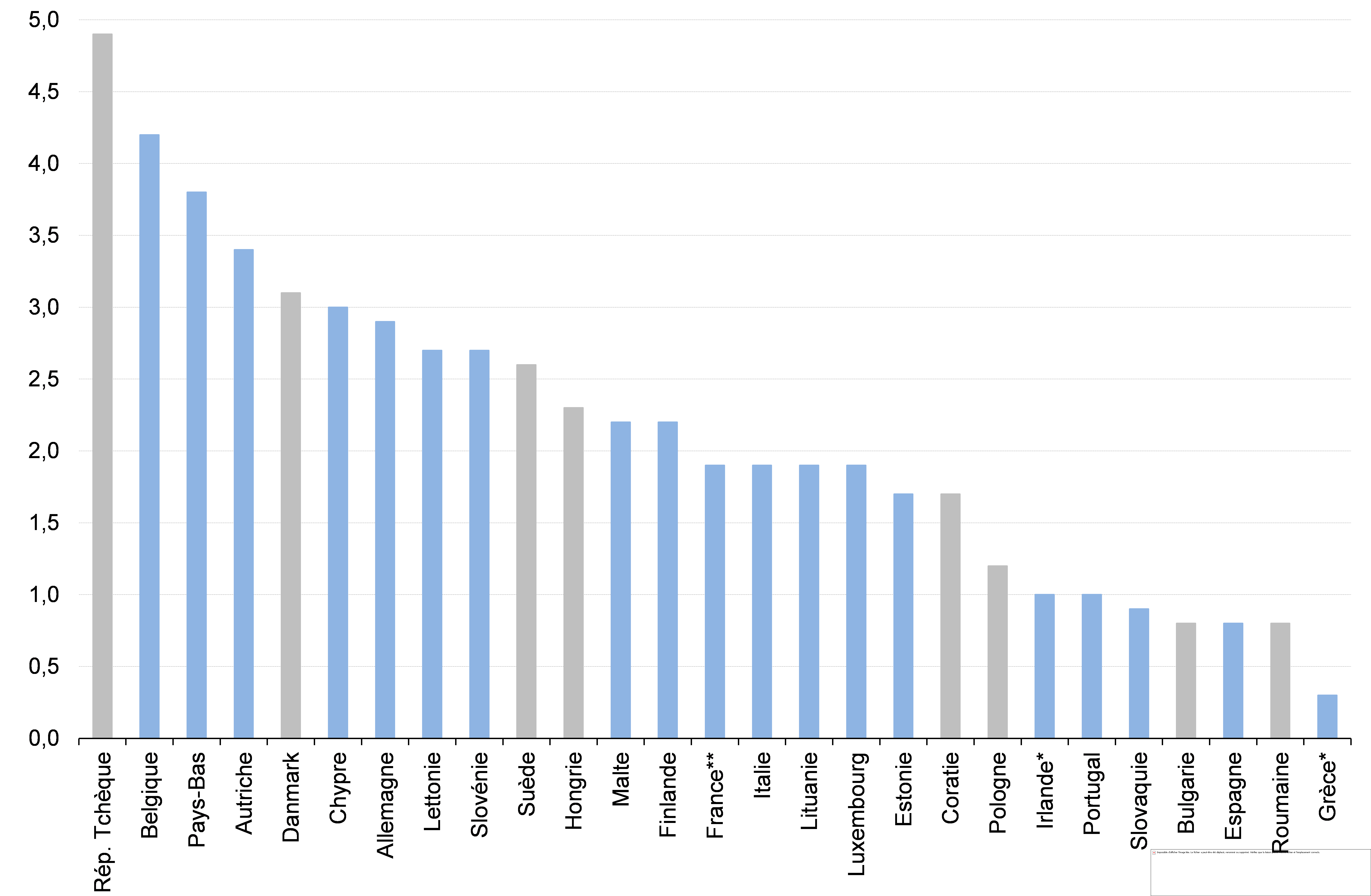Hot weather on prices
Post by Agnès Bénassy-Quéré, chief economist of the French Treasury.
Autumn is coming, temperatures are dropping. Before turning on the boiler, everyone will have a look at the spectacular rise in the price of gas (figure 1), which the Government has decided to freeze (for the regulated tariff, no pun intended) from October, considering that part of this rise will be transitory and that the price paid by the consumer can therefore be smoothed.
What remains are the past increases, which will affect households differently depending on their heating method. As a consolation, those who, like me, are heated with gas, will note that the price of wool is still about 30% lower than before the crisis. Rather than pushing the heat, we can buy woolens.
Figure 1. Natural gas prices in euros (TTF futures)
Source: Insee, Note de conjoncture, 6 October 2021.
Price signal or inflation
The year 2021 thus ends with a natural experiment in a double price signal: carbon-based energy (gas and, to a lesser extent, oil) increases in price relative to nuclear, hydro, solar and wind power; and the price of different energies increases relative to other goods and services. While some are trying to understand the interconnection of electricity markets or to calculate the impact of this double shock on carbon emissions, central banks are wondering whether the inflationary surge is sustainable or temporary. And there, surprise, there is a certain serenity in the euro zone, summarised by Isabelle Schnabel, member of the European Central Bank's Executive Board, in a recent speech: the 3.4% rise in the harmonised index of consumer prices in the euro zone in September 2021 compared with September 2020 (in France, +2.7% for the harmonised index and +2.2% for the index calculated by INSEE using a slightly different method) would only be a "sneeze" and not the start of a pneumonia. Indeed, the rise is not unprecedented in the young history of the euro area (figure 2). The ECB expects inflation to fall back below 2% as early as 2022.
Figure 2: Consumer price inflation (blue) and core inflation (yellow) in the euro area, year-on-year (%)
Source: European central bank.
The temporary factors that are currently pushing up inflation are well known: base effects (price rises are measured against exceptionally low levels in 2020), rapid and unexpected recovery in demand, disruption of freight, low stock levels, lack of wind in recent months, early winter in Russia (5°C in Moscow as early as September!), temporary production cuts (semiconductors, oil, gas, vegetable oils), chain effects in other markets (electricity). Thus, the price rises observed in recent months are not necessarily sustainable, even if the downturn should be faster for some supplies (gas) than for others (semi-conductors).
Prices and wages
In the 1970s, an increase in energy prices of 9.3%, as forecast by INSEE for 2021 in France (after a 6.1% drop in 2020), would undoubtedly have triggered an inflationary spiral: largely indexed to prices at the time, wages would have automatically risen, which would have increased production, and therefore consumer prices, and therefore wages, etc. And the French franc would have been devalued. Today, this chain of events is far from being mechanical, due to greater competition between producers (within each country and between countries), consumption that is still below its pre-crisis level and an irrevocably fixed exchange rate within the euro zone. The main question is the labour market: will the current pressure on recruitment lead to significant wage increases? For the time being, experts do not see a boom in this area in Europe, although they remain cautious.
The recruitment difficulties of companies are real, but so far they remain less than those that prevailed before the crisis, at least in France (graph 3). And at the time, this did not prevent above-potential growth in activity, for a moderate rise in wages. Moreover, according to the August 2021 Acemo-Covid survey (Dares), recruitment difficulties are only really a constraint in certain sectors such as education or health, with companies in other sectors citing input constraints or still demand shortfalls as the main factors limiting production.
Figure 3. Share of firms reporting recruitment difficulties (%)
Source: Insee.
Some inflation is better than no inflation
The general public is often surprised that economists define price stability as inflation of around 2% (or even 4%) and not 0%. While too much inflation is bad for the economy, moderate inflation is better than no inflation. It thus gives space to monetary policy, allowing the real interest rate to be clearly negative even if the nominal interest rate cannot be (at least not much). It also allows relative price adjustments to be made without plunging sectors or countries into deflation. This is particularly important in a monetary union because a country cannot recover competitiveness losses through devaluation. If it is kept under control, as expectations to date seem to indicate, the rise in inflation could thus encourage an adjustment of relative prices between sectors and between countries in the euro zone.
When he was President of the European Central Bank, Jean-Claude Trichet used to hold up a graph showing the comparative evolution of prices in the member countries of the euro area, sounding the alarm well before the 2009 crisis about the cumulative loss of competitiveness of certain countries in relation to others. During the crisis, some countries such as Ireland and Spain experienced a dramatic fall in their relative prices. After the crisis, however, the lack of inflation in the euro area reduced the room for manoeuvre for these adjustments. The current supply-side tension, which is observable in all countries, could be an opportunity to make relative price adjustments without too much pain within the single currency. From this point of view, the fact that recruitment tensions seem to be more marked in countries with a current account surplus (Germany, Netherlands, Belgium) than in countries with a current account deficit (France, Portugal, Slovakia, see graph 4) is encouraging.
Chart 4: Vacancy rates in Q2 2021, not seasonally adjusted, in %.
Source: Eurostat. In blue: Eurozone countries. * 2021Q1. ** Firms with at least 10 employees.
Read more:
>> Version française : Coup de chaud sur les prix
>> All posts by Agnès Bénassy-Quéré, chief economist - French Treasury
